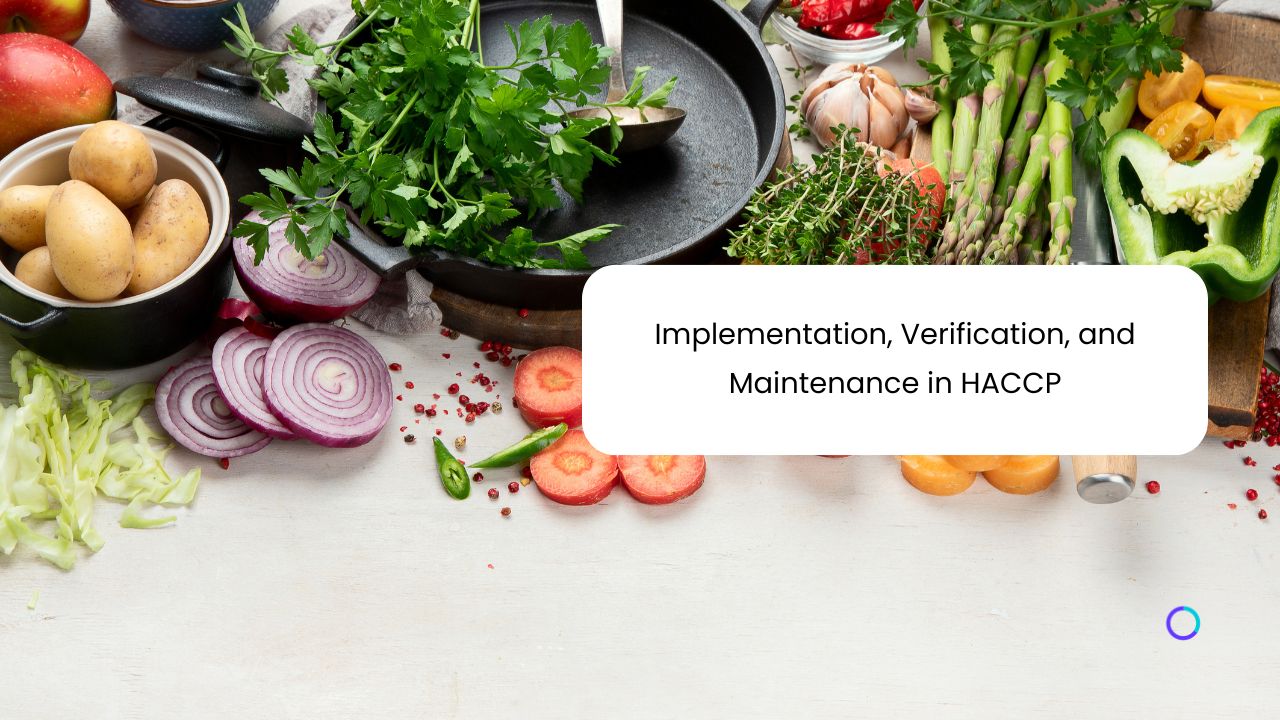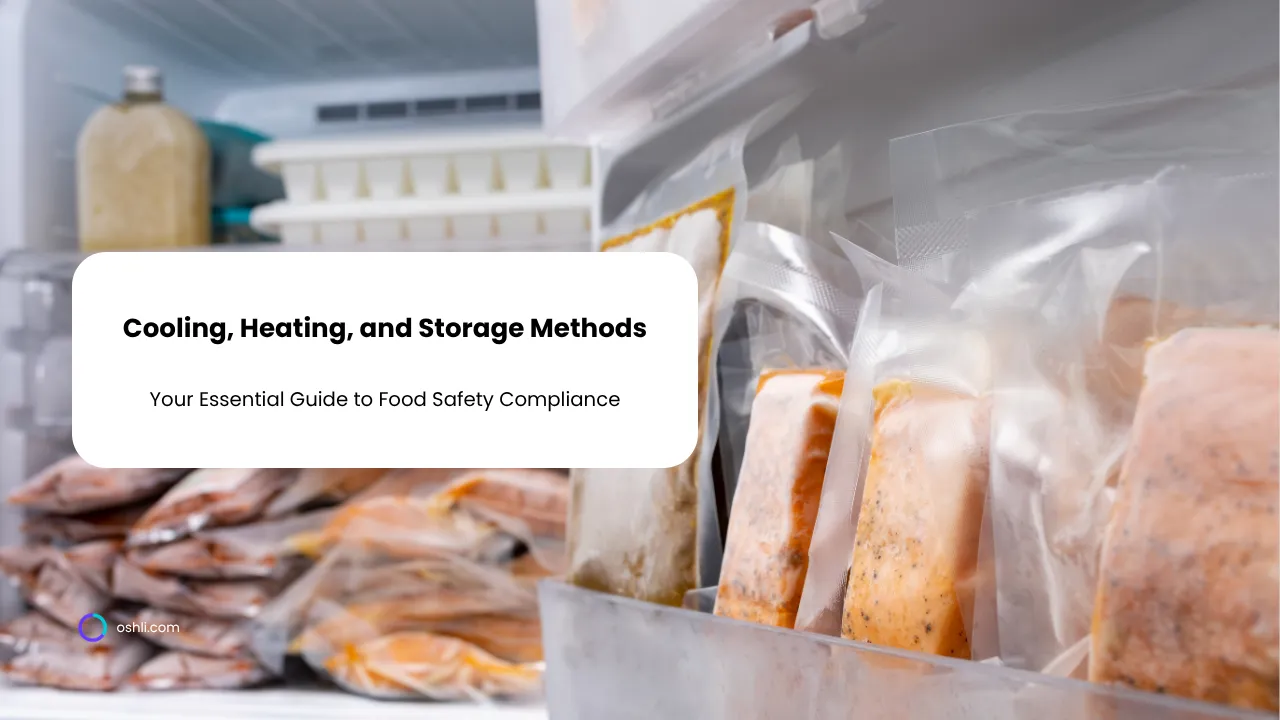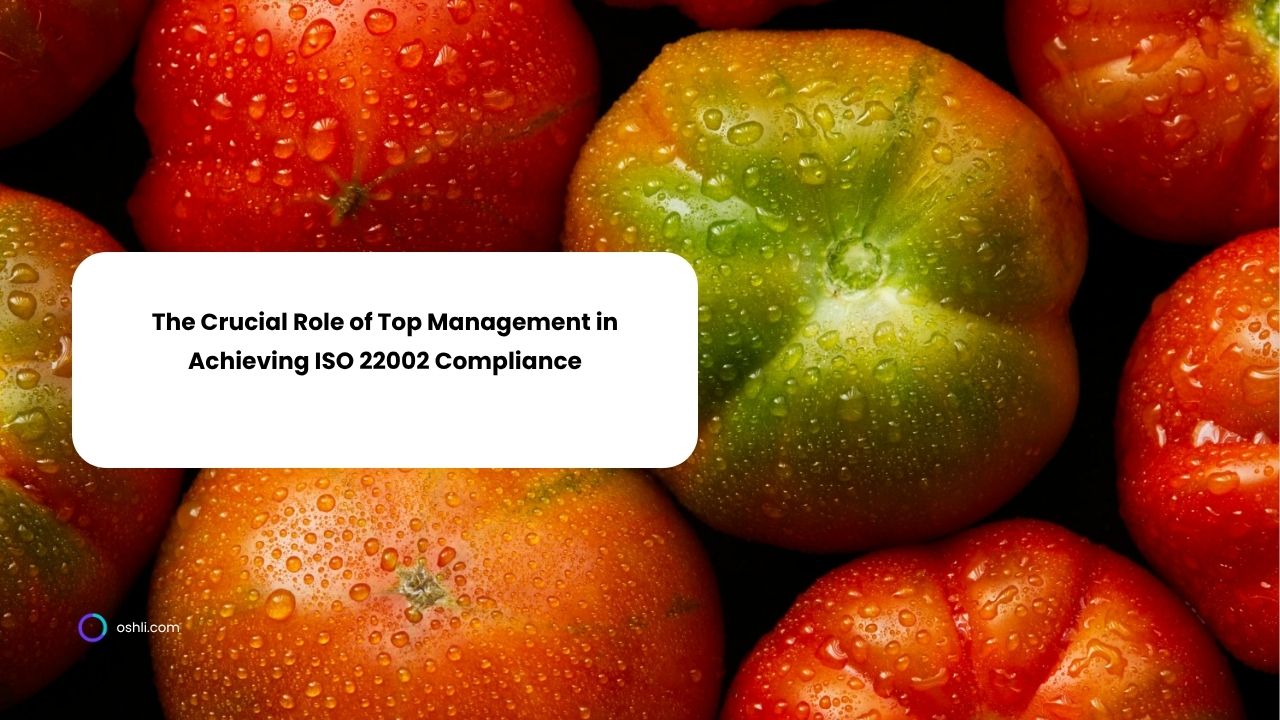
Implementation, Verification, and Maintenance in HACCP
Table of Contents
- Introduction
- Implementation of the HACCP Plan
- The Implementation Requirements and Planning
- Developing Monitoring Records
- The Use of Statistical Techniques for Monitoring
- The Verification of Implementation
- The HACCP System Maintenance
- Share Your Experience
- Conclusion
Introduction
The Hazard Analysis and Critical Control Points (HACCP) system is an internationally recognized methodology for ensuring food safety throughout the supply chain. Its primary goal is to identify, evaluate, and control potential hazards—be they biological, chemical, or physical—that could compromise product safety.
HACCP has evolved into a foundational element of various food safety regulations and certifications worldwide. Beyond compliance, effective HACCP implementation fosters consumer trust, brand protection, and operational efficiency. However, merely creating a HACCP plan is not enough. The true challenge lies in implementing that plan, verifying its effectiveness, and maintaining it over the long term.
In this comprehensive article, we’ll explore:
- Implementation of the HACCP Plan
- Implementation Requirements and Planning
- Developing Monitoring Records
- Using Statistical Techniques for Monitoring
- Verification of Implementation
- Maintenance of the HACCP System
- Sharing Best Practices and Experiences
By understanding these critical areas, food businesses can transition from a theoretical plan to a dynamic, resilient, and continually improving food safety management system.
Implementation of the HACCP Plan
1. From Theory to Practice
The first step in implementing a HACCP plan is translating theoretical principles into day-to-day operations. While the plan may look perfect on paper, the real test comes in the production environment, where equipment, personnel, and raw materials are subject to constant changes and external influences.
2. Training and Competence
An essential element of HACCP implementation is ensuring that personnel at all levels understand their roles and responsibilities. This includes:
-
Managers and Supervisors: They must be fully aware of the HACCP principles, understand how to identify and control hazards, and know how to respond to non-conformities.
-
Operators and Line Workers: They should receive specific training on the Critical Control Points (CCPs) relevant to their tasks, the monitoring procedures, and the corrective actions they must take when deviations occur.
Training should not be a one-time event. Ongoing refresher courses, toolbox talks, and on-the-job coaching are crucial to maintain awareness and ensure staff remain up to date with any procedural or regulatory changes.
3. Aligning Processes and Infrastructure
Before a HACCP plan can be fully implemented, processes and infrastructure must be aligned with its requirements. This might include:
- Facility Layout: Ensuring a logical flow of materials from receipt to dispatch to minimize cross-contamination.
- Equipment Upgrades: Introducing or updating machinery (e.g., metal detectors, X-ray machines, temperature control units) to meet critical limits.
- Preventive Maintenance: Establishing a robust maintenance schedule to reduce the risk of equipment failures that could compromise food safety.
- Sanitation and Hygiene Programs: Adapting existing cleaning schedules to ensure they meet or exceed HACCP standards.
4. Setting Clear Objectives and KPIs
To measure the success of HACCP implementation, organizations should establish Key Performance Indicators (KPIs). Examples of KPIs include:
- Number of Deviations at CCPs per month
- Percentage of Corrective Actions completed on time
- Compliance Rate with internal audits
- Customer Complaints related to food safety
Clear objectives, coupled with measurable KPIs, enable management to track progress and identify areas needing improvement.
The Implementation Requirements and Planning
1. Legal and Regulatory Requirements
Before you begin any HACCP implementation plan, it is imperative to be aware of local, national, and international regulations governing food safety. Many countries have regulations that either directly mandate HACCP or heavily reference its principles. Examples include:
- EU Regulations such as Regulation (EC) No 852/2004
- Codex Alimentarius guidelines on HACCP
Meeting these requirements is often the baseline for HACCP implementation, so regulatory research should be a top priority during the planning phase.
2. Preliminary Steps for HACCP
In the Codex Alimentarius HACCP model, there are five preliminary steps before you even get to the seven HACCP principles:
- Assemble the HACCP Team: Gather a cross-functional team with expertise in operations, quality, engineering, and procurement.
- Describe the Product: Clearly define the characteristics of the product, including raw materials, packaging, and shelf-life requirements.
- Identify Intended Use: Specify the target consumers, whether it’s the general population or vulnerable groups (e.g., infants, elderly, immunocompromised).
- Construct Flow Diagram: Map out the entire process from ingredient receiving to final product dispatch.
- On-site Confirmation of Flow Diagram: Verify the accuracy of the flow diagram by physically walking through the process.
These steps ensure the HACCP team has a comprehensive understanding of the product and process, laying a solid foundation for hazard analysis.
3. Resource Allocation
Effective planning includes allocating the necessary resources—human, financial, and technological—to support HACCP. This may involve:
- Hiring or training food safety specialists
- Investing in monitoring equipment (thermometers, pH meters, data loggers)
- Budgeting for laboratory testing and third-party audits
- Setting aside funds for contingencies, such as product recalls or unexpected equipment failures
Without adequate resources, even the most well-designed HACCP plan can falter.
4. Communication Strategy
A robust communication strategy ensures that all stakeholders—from top management to line operators—understand the importance of HACCP and their role within it. Effective communication channels include:
- Regular Team Meetings: Provide updates on progress, challenges, and new regulations.
- Bulletin Boards and Digital Displays: Post key metrics, reminders, and tips on food safety.
- Intranet or Shared Platforms: Centralize documentation, training materials, and standard operating procedures (SOPs).
When everyone in the organization is on the same page, implementation proceeds more smoothly and with greater accountability.
Developing Monitoring Records
1. Importance of Record-Keeping
Record-keeping is a cornerstone of HACCP. Proper records enable:
- Verification: Proving that critical limits are consistently met.
- Traceability: Facilitating recalls by identifying affected batches or lots.
- Continuous Improvement: Identifying trends and recurring issues that may require process adjustments.
- Regulatory Compliance: Providing evidence of due diligence during inspections or audits.
2. Types of Monitoring Records
Different stages of the food production process will require specific monitoring records. Common examples include:
- Temperature Logs: Recording cooking, cooling, or storage temperatures at predefined intervals.
- Cleaning and Sanitation Checklists: Documenting when, how, and by whom equipment and facilities were cleaned.
- Equipment Calibration Records: Ensuring that thermometers, scales, and other measuring devices are accurate.
- Supplier Certificates of Analysis (CoA): Verifying that incoming materials meet specified quality and safety standards.
- Corrective Action Reports: Outlining the steps taken to address deviations from critical limits.
3. Digital vs. Paper-Based Systems
Organizations can choose between digital and paper-based systems for record-keeping:
- Paper-Based Systems: Often used by smaller operations or those with limited access to technology. While simple and accessible, paper records can be prone to errors, duplication, and physical damage.
- Digital Systems: Automated solutions using cloud-based software, tablets, or mobile apps. Digital systems offer advantages like real-time data capture, automatic alerts, and data analytics. However, they require initial investment, staff training, and robust IT infrastructure.
4. Best Practices for Effective Monitoring Records
- Clarity: Records should be easy to read and understand, with clear headings and instructions.
- Consistency: Follow the same format for data collection to facilitate comparison over time.
- Timeliness: Record data at the time of measurement, not later.
- Accountability: Require signatures or digital IDs to confirm who performed the monitoring and when.
- Security: Ensure records are backed up and stored securely to prevent unauthorized access or accidental loss.
The Use of Statistical Techniques for Monitoring
1. Why Statistical Techniques Matter
Statistical techniques help organizations make sense of large volumes of data collected through monitoring activities. By analyzing trends and variations, food safety teams can:
- Detect early signs of deviations
- Identify root causes of recurring issues
- Evaluate the effectiveness of corrective actions
- Optimize process parameters for consistent quality
2. Common Statistical Tools
Control Charts (e.g., X-Bar, R-Charts):
- Purpose: Track process performance over time, highlighting any shifts or trends that fall outside normal variability.
- Application: Monitoring cooking temperature, pH levels, or microbial counts.
Pareto Analysis:
- Purpose: Identify the most significant factors (e.g., top contributors to non-conformities) based on the 80/20 rule.
- Application: Targeting the major causes of deviations or defects to focus improvement efforts.
Histogram and Distribution Analysis:
- Purpose: Understand the distribution of a dataset, whether it’s normal or skewed.
- Application: Evaluating fill weights, moisture content, or ingredient proportions.
Trend Analysis:
- Purpose: Compare data points over specific time intervals to identify any upward or downward trends.
- Application: Monitoring microbial load over multiple production cycles to detect seasonal variations.
3. Interpreting Statistical Results
Simply generating charts or graphs is not enough. The real value lies in interpretation:
- Identifying Outliers: Points lying outside control limits may indicate equipment malfunction, human error, or raw material issues.
- Investigating Trends: Sustained trends suggest that the process may be drifting away from desired parameters.
- Setting Action Thresholds: Organizations can set early warning limits that trigger a preventive response before a critical limit is breached.
4. Integrating Statistical Monitoring into Daily Operations
To make the most of statistical techniques, integrate them into the routine activities of your HACCP team:
- Automate Data Collection: Use sensors and software to continuously gather data.
- Schedule Regular Reviews: Hold weekly or monthly data review meetings to discuss findings.
- Continuous Improvement Loop: Use insights from statistical analysis to refine SOPs, update training, or invest in new technologies.
The Verification of Implementation
1. Purpose of Verification
Verification is the process of confirming that the HACCP plan is being followed correctly and is effective in controlling hazards. It differs from validation, which is about proving that the theoretical plan can achieve the desired level of safety under ideal conditions. Verification focuses on real-world performance.
2. Methods of Verification
Internal Audits:
- What: Periodic checks by trained internal auditors to assess compliance with HACCP procedures, documentation accuracy, and staff understanding.
- Why: Provides an internal checkpoint to catch issues before external inspections.
External Audits:
- What: Conducted by third-party certification bodies or regulatory agencies.
- Why: Offers an objective assessment and can lead to certification or regulatory approvals.
Sampling and Testing:
- What: Laboratory analysis of product samples for microbial, chemical, or physical hazards.
- Why: Confirms that products consistently meet safety standards.
Equipment Calibration and Validation:
- What: Regular calibration of thermometers, scales, metal detectors, etc.
- Why: Ensures monitoring devices remain accurate over time.
Review of Records:
- What: Checking logs, corrective action reports, and training records.
- Why: Confirms that staff are performing tasks as specified and that documentation is complete and accurate.
3. Frequency of Verification
The frequency of verification activities should be risk-based and determined by:
- Nature of the Product (e.g., high-risk products like dairy or seafood may require more frequent checks)
- Complexity of the Process (multiple CCPs may demand more regular audits)
- Regulatory Requirements (some jurisdictions mandate specific audit intervals)
- Past Performance (history of non-conformities or recalls may prompt more frequent verification)
4. Handling Non-Conformities
When verification activities uncover non-conformities—whether minor (e.g., missing data in a log) or major (e.g., a repeated failure to meet a critical limit)—it’s crucial to follow a structured process:
- Root Cause Analysis: Determine why the non-conformity occurred.
- Corrective Action: Implement immediate measures to address the issue (e.g., product hold, rework, or disposal).
- Preventive Action: Revise procedures, provide additional training, or update equipment to prevent recurrence.
- Follow-up: Re-verify to ensure the corrective and preventive actions are effective.
The HACCP System Maintenance
1. Continuous Improvement
A HACCP system is not static. As products, processes, and regulations change, so must your HACCP plan. Continuous improvement involves:
- Regular Review of Hazard Analysis: New ingredients, suppliers, or technologies may introduce new hazards or change existing ones.
- Updates to Procedures: Adjust cleaning schedules, monitoring frequencies, or critical limits based on audit findings and scientific advancements.
- Management Review: Top management should conduct periodic reviews to assess the HACCP system’s effectiveness and allocate necessary resources.
2. Change Management
Change management is crucial when introducing any alteration to your process or product. Examples of changes include:
- New Equipment: Requires updated risk assessments, staff training, and possibly new CCPs.
- New Product Lines: May demand a separate HACCP plan or significant revisions to the existing one.
- Revised Regulations: Adjustments to comply with new legal standards or guidelines.
- Process Optimization: Modifications to reduce costs or improve quality, which may affect hazard control.
Each change should trigger a mini-hazard analysis to evaluate its impact on existing CCPs, PRPs (Prerequisite Programs), and overall food safety risks.
3. Documentation Updates
An up-to-date HACCP system is only as good as its documentation. This includes:
- Standard Operating Procedures (SOPs)
- Work Instructions
- HACCP Plan Documents
- Corrective Action Procedures
- Verification Records
Whenever a procedure is modified, or a new hazard is identified, documentation should be revised promptly. Failure to keep documentation current can lead to confusion among staff, missed controls, and non-compliance during audits.
4. Resource Reassessment
Maintenance also involves periodically reassessing whether the resources allocated to HACCP remain sufficient:
- Staffing Levels: As production increases or becomes more complex, you may need additional trained personnel.
- Budget: Ongoing costs for equipment calibration, laboratory testing, and audits must be factored into financial planning.
- Infrastructure: Upgrades to facilities, IT systems, or equipment may be needed to maintain food safety standards.
Share Your Experience
1. Learning from Others
One of the best ways to refine your HACCP system is by learning from the experiences of other organizations. Industry forums, professional networks, and conferences often serve as platforms to discuss:
- Innovative Monitoring Tools
- Success Stories from companies that drastically reduced non-conformities
- Common Pitfalls encountered during HACCP implementation
2. Peer Audits and Benchmarking
Conducting peer audits—where a food safety team from another facility audits your processes—can provide fresh insights. Benchmarking against industry leaders helps identify best practices and performance gaps.
3. Internal Communication and Feedback Loops
Encourage open communication within your organization. Operators on the production floor often have valuable observations about the practicality of monitoring procedures or the adequacy of training materials. By fostering a culture of continuous feedback, you empower employees to contribute to HACCP improvements.
4. Celebrating Milestones
Acknowledging milestones—such as a year without a major non-conformity, achieving a new certification, or successfully completing a challenging audit—boosts morale and emphasizes the importance of HACCP to the entire organization. Celebrations and recognitions also reinforce positive behavior and commitment to food safety.
Conclusion
Implementing, verifying, and maintaining a HACCP system is an ongoing journey that demands diligence, adaptability, and collaboration across all levels of an organization. From initial planning and resource allocation to daily monitoring, statistical analysis, and corrective actions, every stage requires careful attention to detail.
Key Takeaways:
- Thorough Planning: Involves understanding regulatory requirements, assembling a skilled HACCP team, and ensuring resources are in place.
- Effective Implementation: Translates theory into practice through training, infrastructure alignment, and well-defined SOPs.
- Monitoring and Record-Keeping: Provides the data needed to identify trends, prove compliance, and take corrective actions promptly.
- Verification: Ensures that the HACCP plan is working as intended in real-world conditions.
- Maintenance and Continuous Improvement: Keeps the system current in the face of changing products, technologies, and regulations.
- Collaboration and Communication: Engages every stakeholder in a shared commitment to food safety.
By embracing these principles, organizations can not only protect consumers but also enhance their reputation, minimize waste, and drive sustainable growth in the competitive food industry.
Join our newsletter!
Enter your email to receive our latest news.
Don't worry, we don't spam
Related Articles

Guide to Developing a Professional Checklist for ISO 45001 Diagnostic Audits
The ISO 45001 standard establishes a framework for Occupational Health and Safety Management Systems (OHSMS), aiming to enhance employee safety, reduce workplace risks, and create safer working conditions. A diagnostic audit aligned with ISO 45001 is a proactive approach that allows organizations to assess current compliance, identify weaknesses, and prioritize improvements. Central to this process is a professionally structured checklist that ensures consistency, accuracy, and depth in audit execution.

Cooling, Heating, and Storage Methods: Your Essential Guide
Discover how to create a cooling, heating, and storage methods template to ensure food safety, meet compliance, and optimize temperature control with free templates.

The Crucial Role of Top Management in Achieving ISO 22002 Compliance
Explore how top management's leadership drives ISO 22002 compliance, ensuring robust food safety management through commitment, policy, and oversight.


